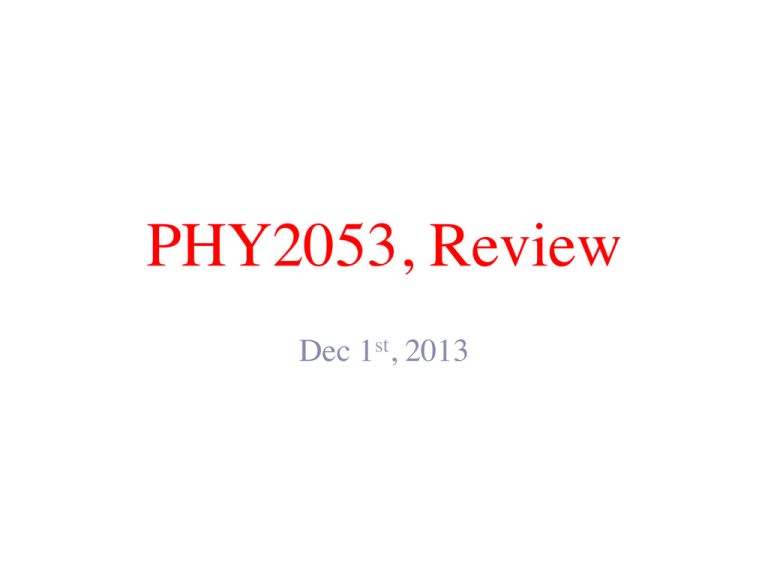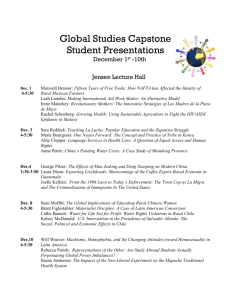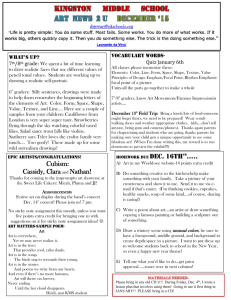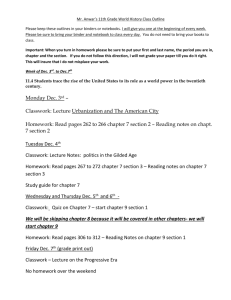Document 10455467
advertisement

PHY2053, Review Dec 1st, 2013 Problem 1 ● Given the following vectors: ~ = 2x̂ B ~ = 1x̂ + 5ŷ A 3ŷ ● What is the value of the following expression? ~ B| ~ |A ● Answer: 2.24 ~ + B| ~ |A PHY2053, Fall 2013, Review, Dec 1, 2013 Problem 2 ● A large horn with fundamental frequency f0 = 500 Hz is mounted on a car that is moving to the left at speed V. An observer in another car is moving to the left at speed 2V as shown in the figure. If the speed of sound in the air is 343 m/s and V = 20 m/s, what frequency does the observer hear? ● Answer: 527.5 Hz PHY2053, Fall 2013, Review, Dec 1, 2013 Problem 3 ● A uniform disk with mass M, radius R= 0.5 m, and moment of inertia I = MR2/2 rolls without slipping along the floor at 2 revolutions per second when it encounters a long ramp angled upwards at 45° with respect to the horizontal. How high above its original level will the center of the disk get (in meters)? ● Answer: 3.0 m PHY2053, Fall 2013, Review, Dec 1, 2013 Problem 4 ● The ideal mechanical advantage is defined to be the ratio of the weight W to the force of the pull Fp for equilibrium (i.e. W/Fp in equilibrium) Assuming that the pulleys rotate without friction and without the rope slipping, what is the ideal mechanical advantage of the combination of pulleys shown in the figure? ● Answer: 7 PHY2053, Fall 2013, Review, Dec 1, 2013 Problem 5 ● At time t = 0s, a 2 kg object’s position and velocity are ~r = (2m)x̂ + (3m)ŷ ~v = ( 6m/s)ŷ ● It is subject ta force F~ = (8N)x̂, where x̂ and ŷ are the unit vectors in the x and y-direction, respectively. What are the magnitude of the angular momentum of the particle about the origin and the magnitude of the torque about the origin, respectively? ● Answer: 24 kgm2/s; 24 Nm PHY2053, Fall 2013, Review, Dec 1, 2013 Problem 6 ● What is the minimum radius (in m) that a spherical helium balloon must have in order to lift a total mass of m = 10kg (including the mass of the empty balloon) off the ground? The density of helium and air are ρHe= 0.18 kg/m3 and ρAir = 1.2 kg/m3, respectively. ● Answer: 1.33 m PHY2053, Fall 2013, Review, Dec 1, 2013 Problem 7 ● Near the surface of the Earth, a startled armadillo leaps vertically upward at time t = 0. At time t = 0.5 s it is at a height of 0.98 m above the ground. At what time does it land back on the ground? ● Answer: 0.9 s PHY2053, Fall 2013, Review, Dec 1, 2013 Problem 8 ● A thin stick with mass M, length L, and moment of inertia ML2/3 is hinged at its lower end and allowed to fall freely as shown in the figure. If its length L = 2m and it starts from rest at an angle θ = 20° , what is the speed (in m/s) of the free end of the stick when it hits the table? ● Answer: 7.43 m/s PHY2053, Fall 2013, Review, Dec 1, 2013 Problem 9 ● A 1kg beaker containing 2.0 kg of oil (density = 916 kg/m3) rests on a scale. A 2.0 kg block of iron (density = 7860 kg/m3) is suspended from a spring scale and is completely submerged in the oil. Find the equilibrium readings of both scales. PHY2053, Fall 2013, Review, Dec 1, 2013 Problem 10 ● A puck has a mass of 0.129 kg. Its original distance from the center of rotation is 0.4 m and it moves with a speed of 0.8 m/ s The string is pulled downward 0.15m through the hole in the frictionless table. Determine the work done on the puck. PHY2053, Fall 2013, Review, Dec 1, 2013 Problem 11 ● A 2.0-kg block situated on a rough incline is connected to a spring of negligible mass, having a spring constant of 100 N/m. The block is released from rest when the spring is unstretched. The pulley is frictionless. The block moves 20.0 cm down the incline before coming to rest. Find the coefficient of kinetic friction between block and incline. PHY2053, Fall 2013, Review, Dec 1, 2013 Problem 12 ● What percentage of the volume of an iceberg is above the surface of the sea? The density of sea water is 1024 kg/m3 and the density of ice is 917 kg/m3. ● Answer: ~ 10% PHY2053, Fall 2013, Review, Dec 1, 2013





